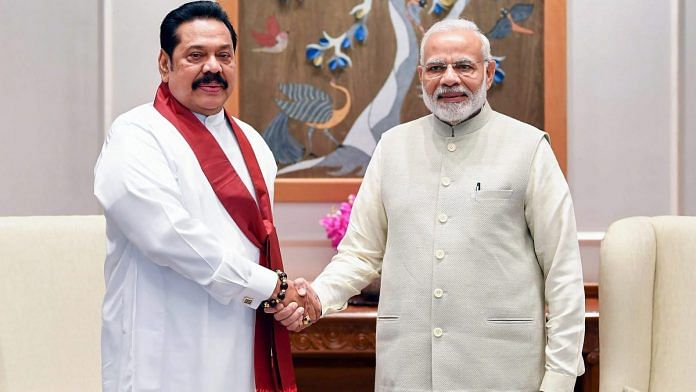Protocol did not demand Modi meet either leader. Yet, he met both, spent an hour with each, and almost treated them like serving heads of govt or state.
New Delhi: Playing hardball, Prime Minister Narendra Modi met former heads of government/state of neighbouring countries in the last week, in a bid to send out a veiled message to the respective regimes of both countries that India will not hesitate to broad-base its relations with the rest of their polity.
While former Prime Minister of Nepal Pushpa Kamal Dahal, more popularly known as Prachanda, visited India from 7-12 September and met Modi on 8 September, former Sri Lankan President Mahinda Rajapaksa, who was also visiting the country, met the PM on 12 September.
Also read: As Nepal taunts India, Delhi loses another friendly neighbour
Protocol did not demand that Modi meet either of the two leaders. Neither are current heads of government and, in fact, Rajapaksa was on a private visit on the invitation of BJP MP Subramanian Swamy. And yet, PM Modi ensured he met both, spent over an hour with each, came out to receive and drop them, and almost treated them like serving heads of government or states. He also posted pictures of the meetings from his official Twitter handle.
According to highly placed sources in the government, this was a well-crafted strategy by the PM to send a camouflaged message to the incumbents in both Nepal and Sri Lanka that India will continue to engage with other political actors in these countries at the highest level, thus keeping its options open.
Sources in the government add that Modi’s decision to meet the leaders, and go out of his way to accord them respect, was a part of the pattern to keep India’s neighbourhood policy flexible and diplomatic. Even though there are qualitative differences between the two situations, Modi’s meetings with both fit into the same paradigm.
The nuance with Nepal
In Nepal, there is a Left government led by the Nepal Communist Party — of which, along with Prime Minister K.P. Oli, Prachanda is chairperson. Thus, by meeting Prachanda, Modi is in a way engaging with the ruling dispensation there. However, this is where, sources say, Modi brought in careful nuance.
In the personalised politics of Nepal, the relations between Oli and Prachanda are delicate. At the moment, India is engaging with Oli closely, but it wants to keep the option open of encouraging Prachanda if Oli crosses security red-lines. More importantly, Oli is seen as being pro-China and India is constantly wary of Beijing’s growing influence and presence in Nepal.
Modi’s warm meeting with Prachanda comes just days after Nepal decided against sending its soldiers for the first-ever BIMSTEC anti-terror military exercise being held in Pune. The move is being perceived as a snub to India. PM Modi, in fact, visited Kathmandu end-August for the two-day BIMSTEC summit.
For Prachanda, the engagement helped give him a leg up in Nepal’s domestic politics. If Oli does fail to give him either prime ministership or ensure he gets elected as the party chair in the next convention, Prachanda wants to make sure he has enough connect with New Delhi to be able to create an alternative coalition.
The Sri Lanka strategy
In Sri Lanka’s case, India is believed to have backed the anti-Rajapaksa side in the country’s 2015 elections, and helped the alternative coalition of Maithripala Sirisena and Ranil Wickremasinghe come together. But over the past year or so, three factors have altered the situation.
President Sirisena and PM Wickremasinghe have developed deep contradictions. While their popularity has plummeted, Rajapaksa is seeming increasingly strong. According to sources, New Delhi now believes India’s incentives in backing the coalition exclusively have diminished.
Also read: Whatever happens in the 2020 election, Colombo cannot play the China card against India
The fact that the coalition has not delivered on economic interests of India, while continuing apace the engagement with China — the reason why New Delhi was upset with Rajapaksa in the first place — has only added to this re-calibration.
For Rajapaksa, meanwhile, meeting PM Modi was an opportunity to neutralise Indian opposition and hostility.
Sources say for now the PM is likely to continue following the two-pronged strategy. In Nepal, engaging with Oli, but keeping Prachanda in good humour as a lever. In Sri Lanka, engaging and continuing to back Sirisena and Wickremasinghe but begin rapprochement with Rajapaksa, both as a signal to the coalition that Delhi has options and a signal to him that India is willing to do business.



